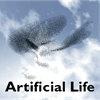复杂性边缘的毛毛虫游行。
IF 1.5
4区 计算机科学
Q4 COMPUTER SCIENCE, ARTIFICIAL INTELLIGENCE
引用次数: 0
摘要
本文论述的是现实社会和人工社会中的个人行进问题。游行是一种最基本的社会形式,在这种社会中,个体的行为要朝着一个既定的方向前进,而组织结构则是由对前方个体的了解决定的。这种简单的分组形式在生物界很常见,而在人类中,游行是一种非常有限的社会活动,其起源肯定非常遥远。这种类型的组织属于微观社会学的范畴,其重点是研究小群体中个体之间的直接互动。在本文中,我们将重点研究松树游行毛虫(Thaumetopoea pityocampa)的特殊情况。在第一部分中,我们提出了 "游行 "概念的正式定义,并比较了昆虫学家进行的现场实验和基于代理的模拟,以研究真实的毛虫游行。在第二部分中,我们将探索毛毛虫可能的生活状态。首先,通过将模型扩展到现实之外,我们可以解释为什么真正的游行毛虫会有这样的行为。然后,我们报告了人为迫使真实毛虫跟随环形队伍的实地实验;这些实验证实,每只毛虫既可以是队伍的领头羊,也可以跟随前面的毛虫。在第三部分中,通过改变人工环形队伍的运动速度,计算模拟让我们观察到了由规则多边形构建的意想不到的移动空间结构的出现,在这种结构中,混乱的运动和井然有序的形式紧密相连。这再次证明,简单的规则可以产生复杂的结果。本文章由计算机程序翻译,如有差异,请以英文原文为准。
Processionary Caterpillars at the Edge of Complexity
This article deals with individuals moving in procession in real and artificial societies. A procession is a minimal form of society in which individual behavior is to go in a given direction and the organization is structured by the knowledge of the one ahead. This simple form of grouping is common in the living world, and, among humans, procession is a very circumscribed social activity whose origins are certainly very remote. This type of organization falls under microsociology, where the focus is on the study of direct interactions between individuals within small groups. In this article, we focus on the particular case of pine tree processionary caterpillars (Thaumetopoea pityocampa). In the first part, we propose a formal definition of the concept of procession and compare field experiments conducted by entomologists with agent-based simulations to study real caterpillars’ processionaries as they are. In the second part, we explore the life of caterpillars as they could be. First, by extending the model beyond reality, we can explain why real processionary caterpillars behave as they do. Then we report on field experiments on the behavior of real caterpillars artificially forced to follow a circular procession; these experiments confirm that each caterpillar can either be the leader of the procession or follow the one in front of it. In the third part, by allowing variations in the speed of movement on an artificial circular procession, computational simulations allow us to observe the emergence of unexpected mobile spatial structures built from regular polygonal shapes where chaotic movements and well-ordered forms are intimately linked. This confirms once again that simple rules can have complex consequences.
求助全文
通过发布文献求助,成功后即可免费获取论文全文。
去求助
来源期刊

Artificial Life
工程技术-计算机:理论方法
CiteScore
4.70
自引率
7.70%
发文量
38
审稿时长
>12 weeks
期刊介绍:
Artificial Life, launched in the fall of 1993, has become the unifying forum for the exchange of scientific information on the study of artificial systems that exhibit the behavioral characteristics of natural living systems, through the synthesis or simulation using computational (software), robotic (hardware), and/or physicochemical (wetware) means. Each issue features cutting-edge research on artificial life that advances the state-of-the-art of our knowledge about various aspects of living systems such as:
Artificial chemistry and the origins of life
Self-assembly, growth, and development
Self-replication and self-repair
Systems and synthetic biology
Perception, cognition, and behavior
Embodiment and enactivism
Collective behaviors of swarms
Evolutionary and ecological dynamics
Open-endedness and creativity
Social organization and cultural evolution
Societal and technological implications
Philosophy and aesthetics
Applications to biology, medicine, business, education, or entertainment.
 求助内容:
求助内容: 应助结果提醒方式:
应助结果提醒方式:


